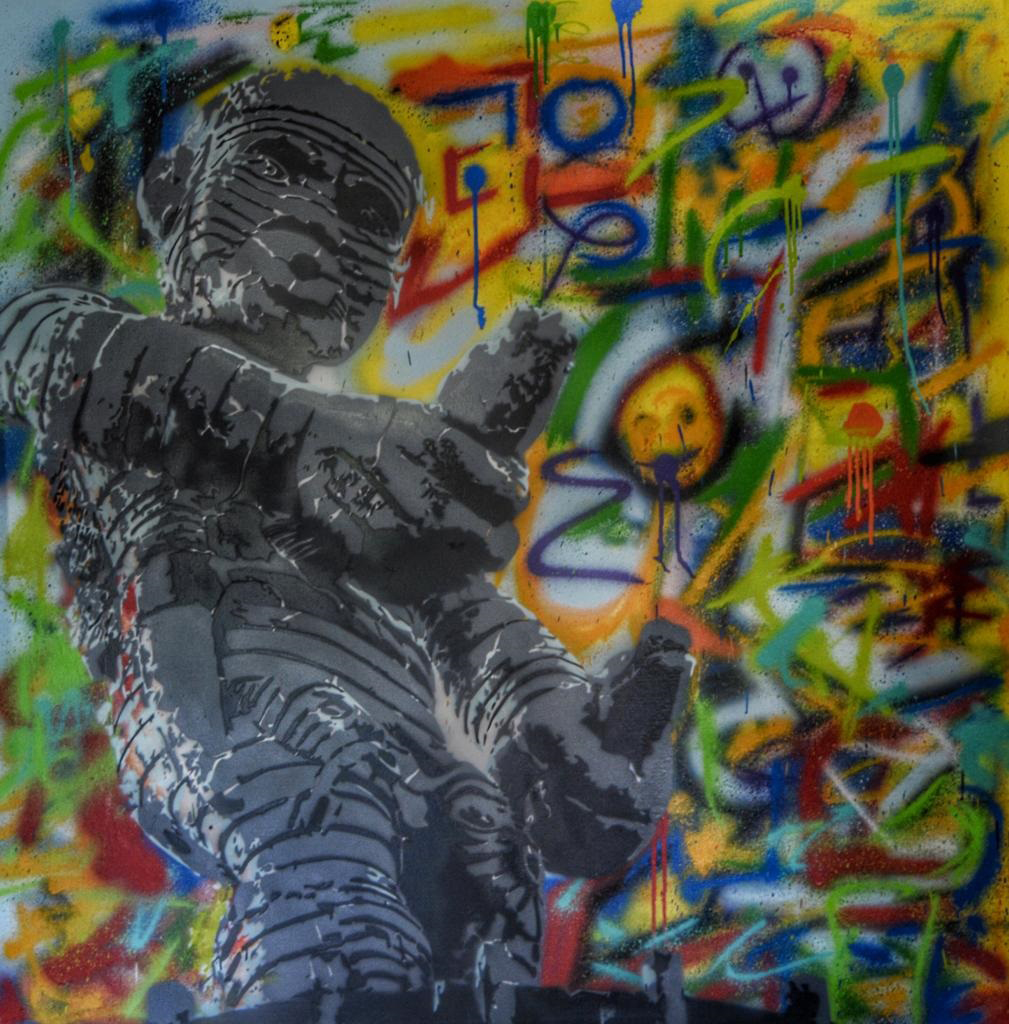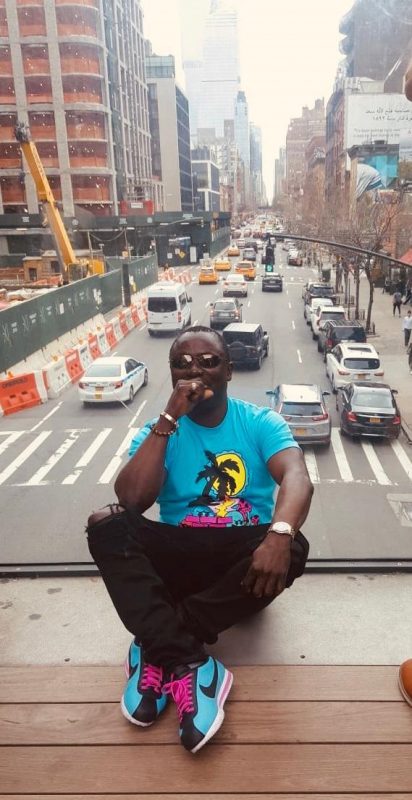US-based Guyanese artist Kwesi Bovell is painting a name for himself. He is yet to figure out the category under which his work falls as he works in several mediums.
“I do a fusion of abstract-based graffiti with a three-dimensional twist to it, so when listing in the generic listings I tick street art and graffiti,” Kwesi told The Scene. “I use acrylics since making the switch back in art school from oils. I was introduced to the golden line of acrylics by Ron Savory back in 1997 and have not switched since. The options for materials are endless in America therefore subject matter becomes more of an issue than material.”
It was in 1997 that Kwesi left the E R Burrowes School of Art, not just as an honour student but valedictorian.
His academic life began at St Patrick’s Nursery School, then St Agnes Primary. As a boy when asked what his intended career was, Kwesi always gave the clichéd answer “a doctor”. However, by the time he was a student at the Bishops’ High, he realized that Math and Science were not his forte and being a doctor was not where his heart was.
Though born in the city, Kwesi was a country boy at heart and he looked forward to his adventures at Linden and Soesdyke during the August vacations. His adventurous spirit and his inquisitive nature landed him in trouble both at school and at home.
Art had always been a subject he loved and on more than one occasion he found himself scribbling on the desk, though he was lucky to have never been caught. Later, he was provided with the necessary materials to pursue his passion but recalled that some were sketch pads made of rice paper, which he gravely hated. When he could choose, he went for the regular sketch pads as they were his preferred size and texture.
The late Chikama Skeete, who was Kwesi’s art teacher at the Bishops’ High played an integral part in him finding new interest in art. His relatives played an instrumental part in this as well. But although his fascination grew during this time, it was not until he was at the University of Guyana, which he attended after he graduated from Burrowes, that he was sure what he wanted to do.
Aside from Skeete, Kwesi was also inspired by Josefa Tamayo, Winslow Craig, Philip Moore and Ron Savory. He drew inspiration from the work of international artists also including Rufino Tamayo and Jean-Michel Basquiat, and just recently has begun paying more attention to the works of Bordalo II, Banksy and Iranian brothers Icy and Sot.
Asked who he would love to meet someday Kwesi said HipHop entrepreneur Kasseem ‘Swizz Beatz’ Dean. Swizz Beatz, he said, is considered to be a gateway to the American minority art world as he understands the needs of the artists and has several initiatives that artists can benefit from.
Though graduating from Burrowes with a major in sculpture and minor in painting, the artist paints more than he sculpts. The materials needed for painting, he explained, are more easily accessible and the results are faster.
Kwesi said, “Art for me is a personal interpretation of an experience, event or idea portrayed in an expressive manner in any art form of choice. Art is a way of life and everything we do or say is affected by art or our lack of art; the way we dress, cook, design clothes, design buildings, combine colours or even do our makeup.” Given the pivotal role art plays in the world, it is sad that artists are frowned upon and considered to be less accomplished or viewed as weird or mad, he added.
Asked to share his best and worst experiences, Kwesi said that his best and also his proudest moment was graduating at the top of his class from Burrowes. His worst and most embarrassing experience came years later when he was asked to be a guest speaker at the H Lavity Stoutt Community College in the British Virgin Islands (BVI). Kwesi was asked to address a graphics class with photoshop being the topic. Unknown to him at the time the school had an updated version of the software and some of the commands and shortcuts varied. In his own words, “I choked in front of a class of about 20 young adults. I look back at it and laugh now, but then it was rather humiliating.”
During the nine years he spent in the BVI, Kwesi was an artist and teacher. Before leaving Guyana in 2003, he taught at the Guyana Education Trust College. Upon leaving, Kwesi journeyed to Botswana where he continued to teach then lived in London for a short period before moving to the BVI.
Since relocating to the US in 2016, Kwesi has done several jobs. “I am an artist first then teacher, interior designer/residential contractor after. I switched from teaching to doing construction after making the move to the USA because I knew I would still need the flexibility that teaching provided in order to produce art. Since art sales are sporadic, I do interior remodelling to complement my income,” he said.
Moving to America posed one of his biggest challenges, but because of the plethora of opportunities, he believes that a person’s success or failure is solely dependent on the person for the most part. While Kwesi would have seen quite a fair share of the world, his work has been seen in more including USA, UK, Botswana, Ghana, Zambia, Canada, Sweden and the Caribbean.
The artist has had his work in quite a few of exhibitions: 2004 – Artists of Ngamiland – Powerhouse Gallery (Maun, Botswana), 2004 – Artists from across the Zambezi – National Henry Tayali Gallery (Lusaka, Zambia), 2010 – BVI Inside Art Gallery – Solo Exhibition (Road Town, BVI), 2015 – Agora Gallery – Modalities of Expression ( New York, USA) and 2017 – Art Basel – The Fearless Artist Group (Miami, USA). He is set to participate at the Art Basel in Miami come December.
Two of his favourite pieces are “Cuffy” (2016) and “Hope” (2017). “Cuffy” was done with acrylic and spray paint on canvas. The graffiti-styled painting was done with the iconic Phillip Moore’s 1763 monument incorporated into it and took more than three weeks to complete. Hope is an acrylic and spray paint, graffiti-styled, three-dimensional painting that took a little over a week to complete.
Speaking on art in Guyana Kwesi said, “For years the arts have been neglected in Guyana; artists do not get the support or exposure needed in order to elevate locally or internationally. There is need for awareness and art education. We as a people need to move away from the ‘shiny is nice’ culture and integrate art more into society rather than sidelining artists and opting for the mass-produced Asian craft replicas. More attention and funding should be given to the art school and Division of Creative Arts (UG), also exchange programmes, scholarships, grants and residences. The art system locally needs a complete overhaul in terms of the awareness and approach to art. To date, Guyana still does not have an artist directory or a catalogued collection of works in the national gallery or any other archived collection.”
For the next decade, Kwesi has several projects in mind, especially for Guyana. He still hopes to do the large wall of the stairwell outside the Division of Creative Arts at UG. This idea had only gone as far as the planning stages, but the actual mural was never brought to fruition. Kwesi would like to see more public art in and around Georgetown and is working towards someday having his work exhibited at the Art Basel, Switzerland and Art Basel, Hong Kong.
Free time for Kwesi is considered to be a thing of the past, but when he could afford the luxury, he enjoyed racing model gas boats which he did when he lived in the BVI.
Follow Kwesi on Instagram as @koolkonduct and on his Facebook art page: Kwesi Bovell.









